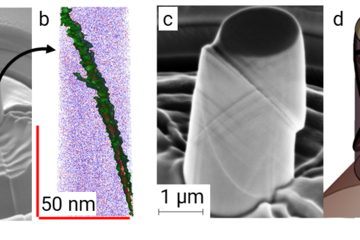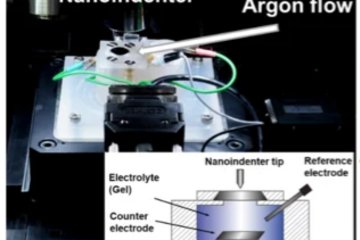All genres
301.
Journal Article
Atomic-scale grain boundary engineering to overcome hot-cracking in additively-manufactured superalloys. Acta Materialia 177, pp. 209 - 221 (2019)
302.
Journal Article
A 2D and 3D nanostructural study of naturally deformed pyrite: assessing the links between trace element mobility and defect structures. Contributions to Mineralogy and Petrology 174, 72 (2019)
303.
Journal Article
Stability of a model Fe–14Cr nanostructured ferritic alloy after long-term thermal creep. Scripta Materialia 170, pp. 134 - 139 (2019)
304.
Journal Article
Microstructural evaluation of a Fe–12Cr nanostructured ferritic alloy designed for impurity sequestration. Journal of Nuclear Materials 522, pp. 111 - 122 (2019)
305.
Journal Article
Atomistic phase field chemomechanical modeling of dislocation-solute-precipitate interaction in Ni–Al–Co. Acta Materialia 175, pp. 250 - 261 (2019)
306.
Journal Article
Direct atomic insight into the role of dopants in phase-change materials. Nature Communications 10, 3525 (2019)
307.
Journal Article
Light, strong and cost effective: Martensitic steels based on the Fe - Al - C system. Materials Science and Engineering A: Structural Materials Properties Microstructure and Processing 762, 138088 (2019)
308.
Journal Article
Combined APT, TEM and SAXS Characterisation of Nanometre-Scale Precipitates in Titanium Alloys. Microscopy and Microanalysis 25 (S2), pp. 2516 - 2517 (2019)
309.
Journal Article
New Applications to Atom Probe Tomography: Insights on Trace Element Diffusion in Naturally Deformed Minerals. Microscopy and Microanalysis 25 (S2), pp. 2498 - 2499 (2019)
310.
Journal Article
On Strong Scaling Open Source Tools for Mining Atom Probe Tomography Data. Microscopy and Microanalysis 25 (S2 ), pp. 298 - 299 (2019)
311.
Journal Article
On the compositional partitioning during phase transformation in a binary ferromagnetic MnAl alloy. Acta Materialia 174, pp. 227 - 236 (2019)
312.
Journal Article
An Integrated Workflow to Investigate Electrocatalytic Surfaces by Correlative X-ray Photoemission Spectroscopy, Scanning Photoemission Electron Microscopy and Atom Probe Tomography. Microscopy and Microanalysis 25 (S2), pp. 306 - 307 (2019)
313.
Journal Article
Correlative Microscopy Observation (3D EBSD + APT + TEM) on Intergranular Corrosion Behaviors in 316L Stainless Steel. Microscopy and Microanalysis 25 (S2), pp. 748 - 749 (2019)
314.
Journal Article
How to write a compelling (materials) science paper. Materialia 6, 100339 (2019)
315.
Journal Article
Quantification of solute deuterium in titanium deuteride by atom probe tomography with both laser pulsing and high-voltage pulsing: influence of the surface electric field. New Journal of Physics 21, 053025 (2019)
316.
Journal Article
Quasi-Fermi-Level Splitting of Cu-Poor and Cu-Rich CuInS2 Absorber Layers. Physical Review Applied 11, 054052 (2019)
317.
Journal Article
On the origin of a remarkable increase in the strength and stability of an Al rich Al–Ni eutectic alloy by Zr addition. Acta Materialia 170, pp. 205 - 217 (2019)
318.
Journal Article
Thermodynamics of grain boundary segregation, interfacial spinodal and their relevance for nucleation during solid-solid phase transitions. Acta Materialia 168, pp. 109 - 120 (2019)
319.
Journal Article
On the effect of Re addition on microstructural evolution of a CoNi-based superalloy. Acta Materialia 168, pp. 37 - 51 (2019)
320.
Journal Article
Building a Library of Simulated Atom Probe Data for Different Crystal Structures and Tip Orientations Using TAPSim. Microscopy and Microanalysis 25 (2), pp. 320 - 330 (2019)











